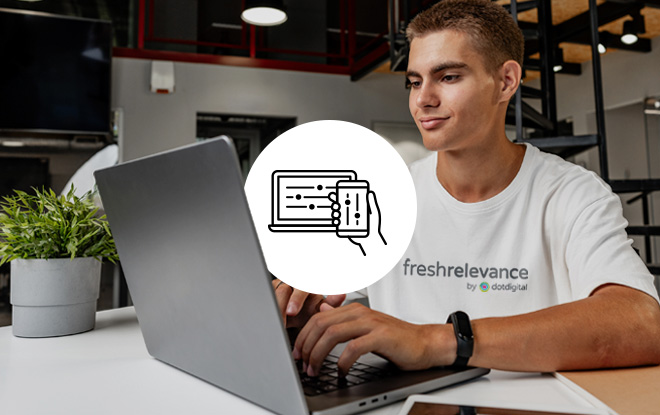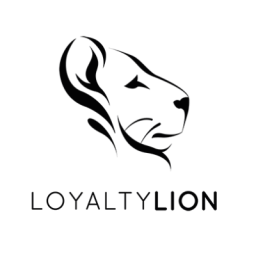learning path
Content personalization 101: a guide for marketers

- What is personalized content?
- What is the difference between personalized and customized content?
- Three benefits of personalized content
- What channels should you personalize content for?
- How does AI help with content personalization?
- Eight examples of personalized content
- Why should you use a content personalization platform?
- How Fresh Relevance can help
What is personalized content?
Imagine browsing a retail website that greets you by name, recommends clothes you love, and highlights deals on your favorite brands. That’s the power of personalized content. It’s content that’s dynamically crafted to cater to the specific interests, needs, and preferences of each user.
This is achieved by leveraging the data points you collect about your audience. These data points can be broadly categorized into two main groups:
- Demographics: This includes information like age, location, education level, gender, employment status, and income. Demographics help you understand the general characteristics of your audience.
- Behavioral data: This is all about how users interact with your content. It includes things like purchase history, browsing history, web page views, time spent on specific pages, and content downloads. Behavioral data gives you a deeper understanding of a user’s individual preferences.
By using a combination of demographic and behavioral data, you can create content experiences that are truly relevant and engaging for each user.
What is the difference between personalized and customized content?
While the terms are often used interchangeably, there’s a subtle difference. Customization allows users to tailor content themselves, for example, by choosing their preferred language or news feed settings. Personalization, on the other hand, leverages data to automatically customize content for each user.
What is dynamic content
Dynamic content refers to the ability to tailor every aspect of the customer experience to an individual’s preferences, behavior, and real-time context. This means that each user is presented with timely and relevant content.
By utilizing dynamic content, marketers can create more personalized and impactful interactions with their customers throughout the entire customer journey.
Three benefits of personalized content
Personalized content goes beyond being a trendy marketing tactic; it’s a strategic approach that can significantly improve your marketing efforts and user engagement. Here’s how:
1. Improves customer experience
Imagine a store where a salesperson instantly recognizes you, remembers your preferences, and suggests products you’ll genuinely love. Personalized content replicates that online. By tailoring content to individual needs and interests, you craft a more engaging and satisfying journey for your users.
This translates to increased satisfaction, reduced frustration, and a higher chance of users returning. Studies show that 74% of consumers feel frustrated by generic content. By providing relevant content, you boost satisfaction, reduce frustration, and encourage repeat visits.
2. Increases sales
Personalized content isn’t just about user happiness; it’s a powerful sales tool. When users see content that resonates, they’re more likely to be interested in your offerings. Targeted product recommendations, personalized ads, and tailored offers can significantly increase conversion rates and drive sales growth.
80% of customers are more likely to buy from brands offering personalized experiences. By delivering content that speaks directly to customer needs and desires, you create a persuasive and compelling marketing strategy that generates revenue.
3. Grows customer loyalty
Today, customer loyalty is more important than ever. Personalized content creates a connection and sense of value between your brand and users. When users feel understood, they’re more likely to trust and be loyal to your brand. This means repeat business, positive word-of-mouth recommendations, and a stronger overall customer base.
Studies show that 52% of customers will switch brands if there’s no personalization. Conversely, brands delivering personalized experiences see a rise in customer loyalty and advocacy. Satisfied and loyal customers become repeat buyers, recommend your brand, and contribute to a stronger customer base overall.
What channels should you personalize content for?
The beauty of content personalization lies in its ability to transform the user experience across various touchpoints. Here’s a look at some key channels where personalization can significantly enhance engagement:
Targeted advertising
Imagine seeing an ad for hiking boots right after reading an article about conquering a mountain trail. That’s the magic of ad personalization. By leveraging user data and browsing behavior, you can deliver highly relevant ads that resonate with individual users, leading to higher click-through rates and conversions.
Dynamic websites
Personalization goes beyond ads. Tailor website content based on factors like user location, browsing history, or past purchases. Imagine a travel website displaying local tours and attractions to a visitor from another country, or an ecommerce site recommending products based on browsing history. This can significantly improve user engagement and conversion rates.
Personalized email marketing
A simple greeting by name can make a big difference in email marketing. Take it a step further by recommending products based on past purchases or offering birthday discounts. Personalized subject lines that pique user interest and mention past interactions can also significantly improve open rates and click-through rates.
Curate social media feeds
Social media platforms are goldmines of user data. Leverage this data to curate personalized content feeds for your followers. You can also target social media ads to specific demographics and interests, ensuring your message reaches the right audience.
Targeted SMS marketing
Don’t underestimate the power of SMS. Send targeted promotions or reminders based on user preferences. For example, a clothing store might send a discount code for a user’s favorite brand or a gym might send a reminder about an upcoming class.
Personalized Apps
Personalize the app experience by displaying relevant content, features, and recommendations based on user behavior within the app. A music streaming app might suggest playlists based on a user’s listening history or recommend similar artists they might enjoy.
How does AI help with content personalization?
Artificial intelligence (AI) has become a game-changer in content personalization. By automating tasks and even content creation, AI allows you to deliver a truly individualized experience for each user. Here’s how AI empowers content personalization:
- Uncover hidden user preferences: AI dives deep into your customer data, including demographics, browsing behavior, and past purchases. It goes beyond the surface, revealing hidden patterns and preferences you might miss. This allows you to understand your audience on a whole new level.
- Predict what customers want next: AI doesn’t just analyze the past, it predicts the future (of user interest, that is). Based on user data, AI can anticipate what your customers might be interested in next. This lets you deliver content that’s not just relevant today but feels eerily in tune with their evolving needs.
- Real-time personalization: Imagine a website that automatically adjusts product descriptions based on a user’s past purchases. That’s the power of AI-powered real-time content creation. This dynamic approach creates a more engaging experience for your customers and can significantly boost conversions.
- Scale up personalization efforts: Manually personalizing content for a large audience is a nightmare. AI automates many of the tasks involved, freeing you up to focus on creative strategy and campaign management. This lets you personalize content at scale, even with a massive user base.
- Constantly improve and refine: AI continuously analyzes the performance of your personalized content, providing valuable insights. This allows you to constantly refine your personalization strategies and ensure you’re delivering the most effective content for your target audience.
AI is a powerful tool that can transform your content personalization. By leveraging AI, you can create personalized experiences that keep your customers engaged and coming back for more.
Eight examples of personalized content
Now you’ve grasped the power of personalized content and its various channels. Let’s explore eight inspiring examples that show personalization in action:
1. Website landing pages: personalized product recommendations
Imagine browsing an online clothing store and encountering a “recommended for you” section curated specifically for your tastes. By analyzing your past purchases and browsing behavior, the store can identify styles and brands you’re likely to favor. This translates into a product selection that feels handpicked just for you, increasing the chances of you discovering something you love and ultimately adding it to your cart.
Personalized product recommendations aren’t limited to clothing stores. Every type of ecommerce store can leverage this powerful tool. A tech store can suggest complementary accessories for a recently purchased laptop, or a travel website recommending hotels and flights based on your past destinations and search history.
By showcasing products that match your customers’ interests and preferences, you enhance their shopping experience, making it both enjoyable and efficient. This fosters brand loyalty and boosts sales.
2. Email: subject lines that grab attention
Generic email subject lines often get lost in the digital clutter. But a personalized subject line that greets you by name and references a product you recently viewed immediately grabs your attention. This piques your curiosity and compels you to open the email, setting the stage for a more engaging experience.
The power of personalization goes beyond greetings. Imagine receiving an email with a subject line like “Hey [Your Name], Did you forget something in your cart?” This clever reminder nudges you to revisit abandoned items, potentially leading to a completed purchase.
Dynamic email subject lines can also leverage past purchases to suggest complementary products or highlight ongoing promotions relevant to your interests. This targeted approach fosters a sense of connection and increases the likelihood of users not only opening your emails but also taking action within them.
3. Social media: feeds curated just for you
Social media platforms are great at personalization. They use user data to tailor your news feed, ensuring that you see content that matches your interests and the accounts you follow. This keeps you engaged and exposes you to relevant content that resonates with your preferences.
However, social media personalization can be even more influential by including on-brand social proof. Imagine scrolling through your feed and seeing your friend raving about a product you’ve been considering, or encountering a post featuring an influencer you trust using a specific brand.
These positive experiences from others can significantly boost your confidence in the product and speed up your decision to purchase. By strategically incorporating social proof into personalized feeds, social media platforms create a compelling and trustworthy user experience that not only keeps you engaged but also nudges you towards making a purchase.
4. Retargeting ads: browsing history
Have you ever researched a specific product online, only to be bombarded with ads for that same product on other websites? That’s targeted advertising at work. By leveraging user data like browsing history and demographics, businesses can deliver highly relevant ads that resonate with individual users. This significantly increases the effectiveness of advertising campaigns, leading to higher conversion rates and a better return on investment (ROI).
Imagine searching for a new pair of running shoes online. Targeted advertising allows athletic brands to display ads showcasing their latest running shoe models directly on the websites you visit. This ensures your ad reaches a pre-qualified audience who is already interested in the product category, making them more likely to click on the ad and potentially convert into a customer.
By strategically targeting your ads based on user data, you ensure your message reaches the right people at the right time, maximizing the impact of your marketing efforts.
5. In-app: personalized app experiences
Imagine a music streaming app that uses your listening history not only to recommend playlists but also to highlight new artists you might enjoy based on your favorite genres.
Similarly, envision a news app that showcases articles related to topics you’ve read, while also incorporating dynamic content such as breaking news updates and personalized weather forecasts.
This level of personalization goes beyond simple recommendations; it leverages dynamic content to create a truly engaging and up-to-date experience for each user. By creating a personalized app experience that feels tailored just for them, you can keep users coming back for more.
6. Location-based personalization: right place, right time content
Taking personalization a step further, you can leverage your GPS data to tailor content and functionality specifically to your whereabouts. Imagine a coffee shop app that uses your location to show cafes near you as well as special deals based on your current spot.
This extends beyond apps. Retail stores can leverage location data to notify customers about nearby sales and promotions relevant to their interests. Imagine getting a notification about a discount on your favorite athletic shoes as you walk past a sporting goods store.
Location-based personalization adds an extra layer of convenience by surfacing relevant information and opportunities right when you need them. This can significantly enhance the user experience and entice users to engage with the app more frequently.
7. SMS messages: birthday greetings
SMS marketing offers a simple yet effective way to personalize content. A birthday greeting with a unique discount code delivered via SMS can make a customer feel valued and appreciated. This small gesture goes a long way in fostering customer loyalty and brand affinity.
But the benefits extend beyond warm wishes. The personalized discount code incentivizes action. Imagine receiving a text message on your birthday that says something like “Happy Birthday, [Your Name]. Enjoy 20% off your entire purchase at [Store Name]. Use code HAPPYBIRTHDAY at checkout.” This targeted offer entices customers to celebrate their special day by treating themselves at your store.
The beauty of SMS marketing lies in its immediacy and high open rates. By delivering personalized birthday greetings with discount codes, you can create a sense of urgency and encourage customers to take advantage of the limited-time offer. This personalized touch fosters a win-win situation: customers feel valued and receive an exclusive offer, while businesses benefit from increased sales and engagement.
8. Push notifications: gentle reminders that keep you engaged
Push notifications can be a powerful tool for personalized content delivery. Imagine a fitness app sending you a gentle reminder to complete your daily workout routine based on your usual exercise schedule.
Personalization goes beyond reminders, ecommerce stores can leverage push notifications to inform customers about flash sales or limited-time offers on products they’ve viewed before.
Travel apps can send personalized updates on flight gate changes or boarding times. The key is to use push notifications strategically and deliver value to the user. Avoid notification overload. By providing timely and relevant updates, push notifications can enhance the user experience and keep them engaged with your app.
Why should you use a content personalization platform?
Content personalization is here to transform your campaigns and boost results. Here’s your step-by-step guide to get started:
- Define your goals
The first step is to identify your goals for content personalization. Are you looking to improve customer experience, increase sales, or boost brand loyalty? Having a clear understanding of your objectives will guide your personalization strategy and help you measure its success.
- Know your audience
Personalization hinges on understanding your audience like the back of your hand. Gather data on demographics, interests, behavior patterns, and pain points. Conduct surveys, analyze website traffic with tools like Google Analytics, and leverage social media insights.
This intel will help you build a buyer persona – a detailed profile of your ideal customer. With a buyer persona in hand, you can tailor content that speaks directly to their needs and interests.
- Choose the right channels
Identify where your target audience spends the most time and where personalization can have the biggest impact. This could be your website, email marketing, social media platforms, or even mobile apps. Focus on high-impact areas first. Don’t spread yourself thin trying to personalize everything at once.
- Start small and scale up
No need to overhaul your entire marketing strategy overnight. Begin with a simple strategy, like personalizing email greetings or website product recommendations based on browsing history. As you gain experience and measure results, you can gradually expand your personalization efforts to encompass more channels and techniques.
- Test and measure
Personalization is an ongoing process, not a one-time fix. Continuously test different personalization strategies and measure their effectiveness. A/B testing allows you to compare the performance of personalized content with non-personalized content. Analyze the results and refine your approach based on what resonates most with your audience. Remember, data is your friend – use it to learn and optimize your campaigns for maximum impact.
- Focus on value
Personalization shouldn’t feel intrusive. Always focus on delivering personalized content that offers genuine value to your audience. This could be through relevant product recommendations that solve their problems, informative blog posts that address their interests, or exclusive discounts that make them feel appreciated. Building trust and relationships with your users through genuine personalization efforts is key to long-term success.
How Fresh Relevance can help
Fresh Relevance empowers you to deliver personalized content experiences that resonate with each customer. Our technology goes beyond basic product recommendations, acting as a powerful tool for tailoring content throughout the customer journey.
Explore more about how Fresh Relevance personalizes your content. Delve into the articles below to learn ways to enhance engagement and conversions with tailored content that connects meaningfully with customers.
A final word on content personalization
Content personalization is a powerful strategy that tailors your content to the specific needs and interests of each user. This blog has equipped you with everything you need to know about content personalization, from its core concepts to the practical steps you can take to implement it.
By leveraging data and understanding your audience, you can create personalized content experiences that resonate with individual users. This not only fosters a more engaging and satisfying user journey but also translates into significant benefits like increased sales, improved customer loyalty, and a stronger brand reputation.
Remember, content personalization is a journey, not a destination. Continuously test, measure, and refine your approach to ensure you’re delivering the most effective content for your target audience.
FAQs
Why is content personalization important?
Content personalization is essential for creating tailored user experiences, enhancing customer engagement, and driving conversions. By tailoring content to your audience’s specific needs and preferences, you boost their satisfaction and foster brand loyalty.
What are the advantages of content personalization in the long term?
Long-term advantages of content personalization include enhanced brand recognition, increased customer loyalty, improved revenue and ROI, and achieving a competitive edge in the market. Personalized content creates memorable experiences that users will associate with your brand.
What is a content personalization platform?
A content personalization platform is a software solution that allows marketers to create and deliver customized digital experiences to individual users. With a content personalization platform, marketers can personalize content all from one centralized hub.








